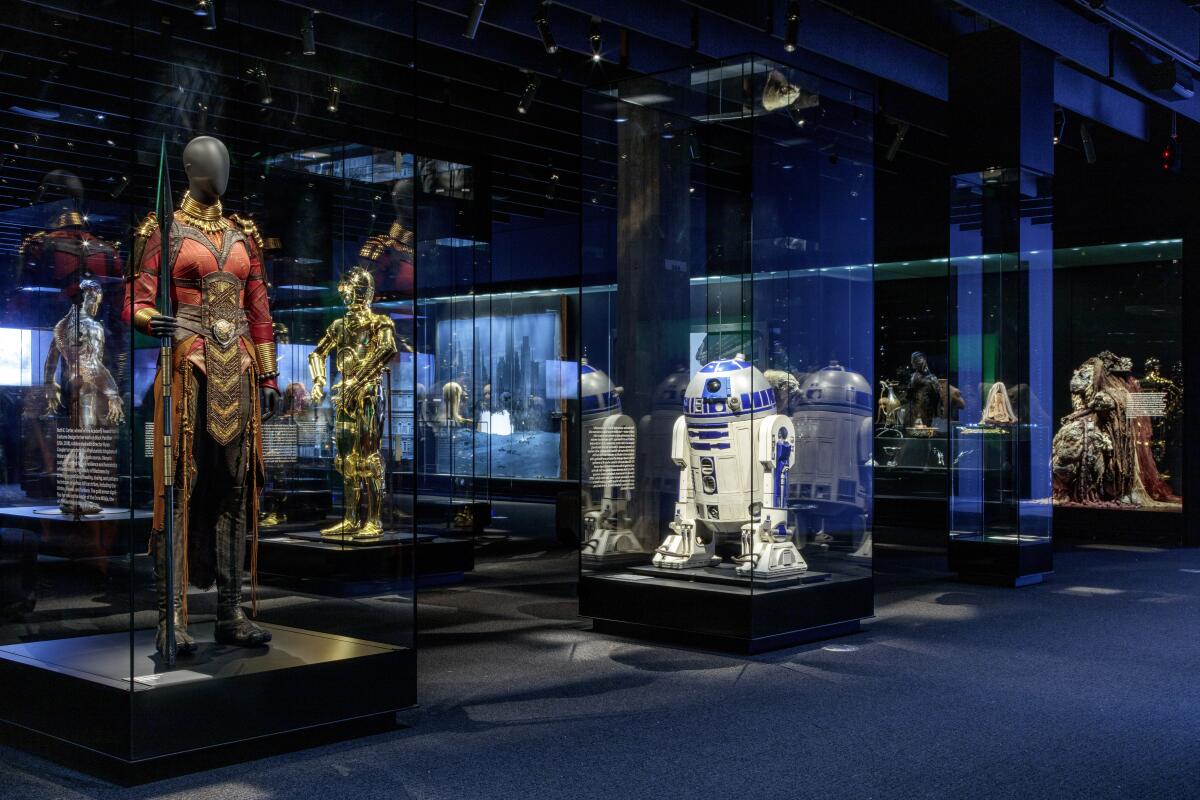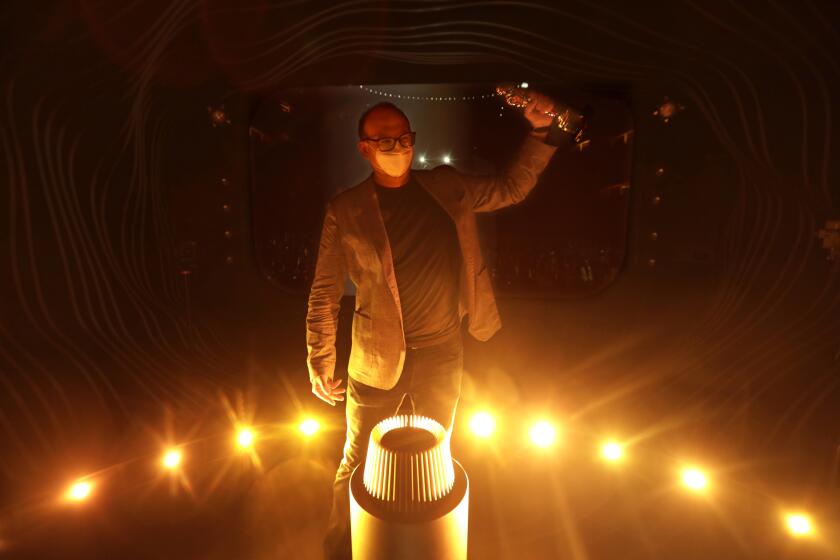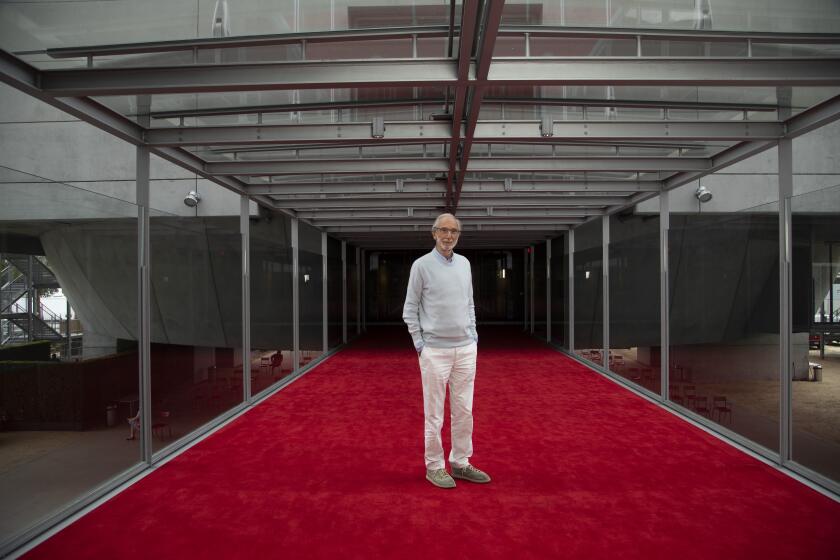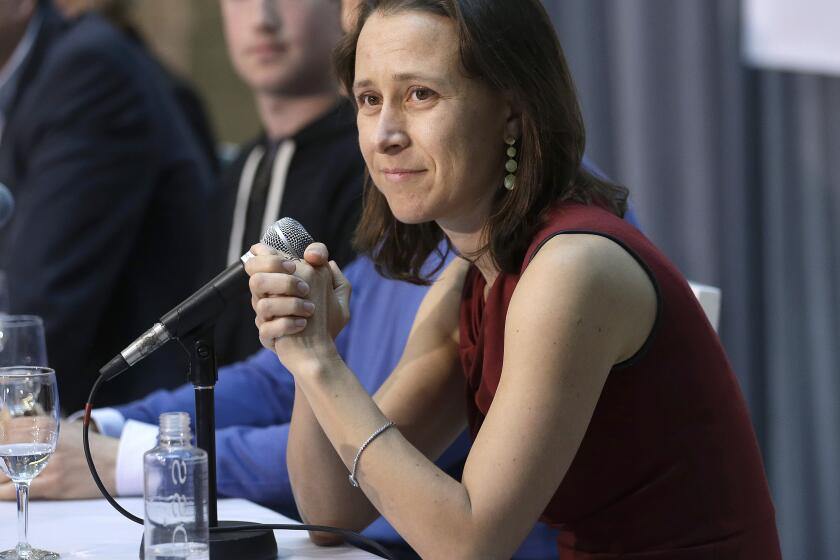Op-Ed: At the Academy Museum, Hollywood’s own labor history is left unexamined

- Share via
In recent weeks, two events have dominated coverage of Hollywood. One is the long-awaited opening of the Academy Museum of Motion Pictures, a Wilshire Boulevard shrine to the magic of moviemaking. The other is the death of a cinematographer after a gun was accidentally discharged on the New Mexico set of the movie “Rust.”
These two events — one celebratory, the other horrifying — have more in common than you might think. The very issues roiling around the death of cinematographer Halyna Hutchins — worker conditions and safety — are older than the Academy of Motion Picture Arts and Sciences. The academy was formed in 1927 to help studios arbitrate contracts with Hollywood unions after the signing of the Studio Basic Agreement, which established a basic framework of labor relations in Hollywood going forward. The shiny gold statuettes, fancy awards ceremonies and museum dreams arrived two years later.
It would take 92 more years to make the museum a reality. The finished product has been met with praise for architect Renzo Piano’s stunning design with its futuristic spherical theater; the cool props displayed, including the droid C-3PO from “Star Wars,” the fiberglass shark from “Jaws” and the Rosebud sled from “Citizen Kane”; the thoughtfully inclusive video montages on the history of cinema; and the kitschy fun simulated Oscar acceptance speech experience.
The Academy Museum is opening with an Oscars experience more akin to a theme park attraction. Expect more like it in future museums.
In particular, the museum has received high marks for how it has grappled with some of the more uncomfortable aspects of Hollywood’s past: an empty spot for Hattie McDaniel’s absent Oscar, the first given to a Black American but missing since sometime after her 1952 death; a display on makeup and hair jars labeled “Tahitian” and “Chinese,” for use on white actors; an exhibit showcasing trailblazing Black filmmaker Oscar Micheaux.
The museum “will be a place for discourse about important social issues connected to both our cinematic history and our industry,” Bill Kramer, the museum’s director, said Thursday in a statement to The Times. He also emphasized that the exhibits will continually evolve “to allow us to keep engaging with new subjects.” Last month, Jacqueline Stewart, chief artistic and programming officer for the museum, emphasized its educational mission, saying “there is an urgency now to conversations about media representation and the power of cinema to shape policy and public opinion.”
But there’s one topic that the museum has not quite confronted: the history of labor and unions in the industry itself. To be fair, it makes a few stabs at it. The exhibit on “The Wizard of Oz” uses the movie as a case study on the contributions of different departments such as publicity, sound and editing. It reminds visitors that the magic was made in “factory-like settings” and gives a nod to the teams of craftspeople who made it happen. Still, the museum presents filmmaking as primarily an artistic endeavor, not an industrial production.
A prominent display on the capacity of movies to influence the public highlights four issues: climate change, the #MeToo and Black Lives Matter movements, and labor relations. The labor section mentions classic films such as “Norma Rae” (1979) and the blacklisted “Salt of the Earth” (1954) and documentaries including “American Factory” (2019) and “Harlan County, USA” (1976). But all of it is focused on labor conflict outside the industry. Labor relations within Hollywood are left unexamined, at least for now. (The Times asked the museum to address the absence of a more comprehensive exhibit on unions and the industry, but Kramer’s statement did not offer a specific comment.)
The Pritzker Prize-winning Italian architect says that L.A.’s new film museum responds to the evolving city
It’s not as if there’s a shortage of material. Unions have played a significant role in the history of Hollywood. Filmmaking was the original gig economy, and how the movie business dealt with solving problems of pay and portable benefits has lessons for today, says Catherine Fisk, a UC Berkeley law professor and author of “Writing for Hire,” a history of labor relations in film, television and advertising.
On such issues as pay, residuals and credits, the unions have helped establish “a system of sector-wide collective bargaining wage and benefit and intellectual property systems that are the envy of video game production, software development” and other tech industries, Fisk says.
But the studios were often deeply antagonistic to the unions and time and again tried to break them. An important part of the Red Scare and the blacklist was an attempt to weaken the unions by suggesting they were havens for communists.
Early on, the unions were often autocratic and riddled with corruption. Organized crime, led by Al Capone associate Frank Nitti, stole millions from the unions and extorted hundreds of thousands more from the studios as protection money during the 1930s and 1940s.
For a long time, the unions were also deeply racist. Excluding Black, Latino and Asian American workers from joining a union effectively kept those workers out of the business altogether. Over time the unions eventually became more democratic and inclusive — and eliminated corruption.
The museum certainly deserves the praise it has received for incorporating the reckonings of recent years into its exhibits. But the industry’s original reckoning — worker rights in Hollywood — is nowhere to be found.
Steve Ross, a historian at USC and author of “Working-Class Hollywood,” understands how a genuine effort to rectify omissions about race and gender could lead to another blind spot. “They’re grappling with presentist concerns rather than looking at the long history of the motion picture industry,” he says. “Isn’t this supposed to be the museum of the motion picture industry? They forgot about the industry part.”
Andy Lewis was an editor at the Hollywood Reporter from 2011 to 2018. He is a former professor of American history at Wesleyan University and Hamilton College.
More to Read
A cure for the common opinion
Get thought-provoking perspectives with our weekly newsletter.
You may occasionally receive promotional content from the Los Angeles Times.












